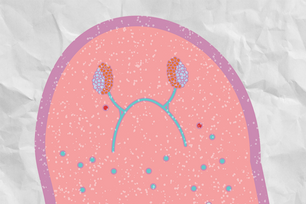Tissue loss triggers regeneration in planarian flatworms

Activity of the follistatin gene in a planarian after its head and tail were cut off
Gaviño et al., 2013, eLife (CC-BY 3.0)
CAMBRIDGE, Mass. – Unlike humans, planarian flatworms have the remarkable ability to regrow any missing body part, making them an ideal model with which to study the molecular basis of regeneration.
Over the years scientists have learned that planarians mount recovery responses that differ depending on the severity of the injury they suffer. For example, a worm with a cut or a puncture wound reacts at the cellular and molecular levels quite differently from one that loses its head or tail. What has remained unclear, however, is just exactly how these responses are triggered.
Whitehead Institute Member Peter Reddien and two of his former graduate students, Michael Gaviño and Danielle Wenemoser, address this longstanding question this week in the journal eLife, revealing a fascinating interplay of signals between two wound-induced genes.
According to the work of Gavino, Wenemoser, and Reddien, regeneration initiation in planarians is regulated by the expression of the genes Smed-follistatin (or fst) and Smed-activin-1 and -2 (or act-1 and act-2), that together act like a switch. After a planarian is wounded, the type of injury determines the level fst expression——the more extreme the loss of tissue, the higher the level of fst expressed. At puncture wounds, fst expression is low, and regeneration is inhibited. However, following amputation, which results in major loss of tissue, fst levels rise and in turn inhibit Activin proteins, allowing regeneration to begin.
To the researchers’ surprise, this interaction only affects regeneration and healing related to injury. Normal maintenance and cell turnover throughout the planarian body continue unaffected when fst is inhibited, even though these activities rely on the same neoblast cell population that creates new tissue during regeneration.
“It’s a really great phenotype,” says Reddien, who is also a Howard Hughes Medical Institute Early Career Scientist and an associate professor of biology at Massachusetts Institute of Technology. “It’s one of the dream phenotypes—to have a defect that’s regeneration-specific, where the neoblasts are working. It’s just regeneration that isn’t working.”
Such a phenotype could be a powerful tool in the further exploration of mechanisms that control regeneration. And many questions about these mechanisms remain.
“For example, the animals know how far to grow in regeneration, so they don’t make tumorous outgrowths,” says Wenemoser, who is now a postdoctoral researcher at Stanford University. “There’s some kind of regulation on homeostatic size, so they’re not growing out all wild and crazy. There’s definitely more to investigate there.”
Gaviño agrees, and points out that the fst/act-1/2 switch may ultimately help scientists tease apart regeneration in other organisms, including humans.
“This regulation by activin and follistatin may be conserved in other systems,” says Gaviño, who is currently a postdoctoral researcher at Univeristy of California, San Francisco. “There are a lot of hints in the scientific literature that versions of activin or follistatin or both are activated by injury and may play a role in regeneration in other animals, but pinning the role of initiating regeneration to them hasn’t happened yet.”
This work was supported by the National Institutes of Health grant R01GM080639 and the Keck Foundation.
* * *
Peter Reddien’s primary affiliation is with Whitehead Institute for Biomedical Research, where his laboratory is located and all his research is conducted. He is also a Howard Hughes Medical Institute Early Career Scientist and an associate professor of biology at Massachusetts Institute of Technology.
* * *
Citation:
Gaviño, M. A., Wenemoser, D., Wang, I. E., & Reddien, P. W. (2013). Tissue absence initiates regeneration through Follistatin-mediated inhibition of Activin signaling. eLife, 2, e00247.
Contact
Communications and Public Affairs
Phone: 617-452-4630
Email: newsroom@wi.mit.edu


